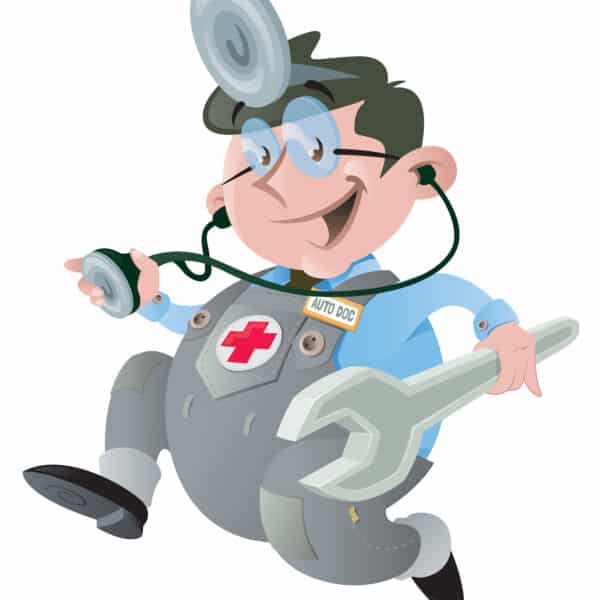
Nowadays it’s not so easy; there are parts of the motor that have labels saying ‘Do not open, service engineers only’. As my knowledge has not kept up with modern mechanics, I’m quite happy to comply with this. I’m also older and lazier, and the thought of rolling around on the hard floor under a dirty engine is not appealing. On the other hand, I’m quite mean and always put off paying someone else to do it.
This policy of only getting the car serviced when the squeaks get too loud has eventually caught up with me, and I’m having to splash out on a lot of work because I’d let a lot of things go too far. Not only that but it failed an MOT because of the type of work required.
I have to extend this analogy to practice life and compliance. Would your practice pass an MOT or CQC visit?
Maintenance as a priority
There are some very practical issues concerning maintenance. For instance, your compressor is the ‘heart’ of the practice, and failure means you`re dead in the water for a day or so until a service engineer can get out to you. From experience, I can tell you it’s not worth the risk. In fact, it is a good policy to have a spare compressor around as a contingency in this scenario. A good maintenance policy is important, as it is also evidence to show CQC that you are risk aware.
Of course, it is a requirement now that all pressure vessels are maintained according to manufacturers’ instructions and that you have a maintenance agreement in force, with regular (logged) safety visits. The updated Cross Infection Control guidelines – HTM 01-05 (2013) – have very detailed maintenance requirements for all equipment used in the process. This is detailed in your Quality Compliance Systems Equipment Safety Policy and Procedures (DCH09) as well as the Cross Infection Control Policy (DCH02).
It’s worth revisiting CQC Outcome 11 – Safety, Availability and Suitability of Equipment, which says we must be aware of making available all the equipment required for our registered activities and the needs of our patients. This means keeping everything well maintained! I have recently been involved in a case where a practice had to send away a patient during surgical removal of a tooth – twice – because equipment failed. The upset and traumatised patient has quite rightly made a complaint, which has been investigated.
Ship’s log Cap’n
Keeping logs of regular maintenance is an important element of collecting evidence of compliance, which will help CQC inspectors make judgements about your practice. Your Quality Compliance Systems DMB01 – Maintenance Policy and Procedure includes some log sheets which can be adapted to most situations. Thinking about this logically, it should be obvious that building a portfolio of logs, for everything from checking the toilets to daily autoclave readings, is an essential part of practice management. Don’t throw anything away!
All employees have a role in maintaining a high standard of maintenance and safety, because we all have to help comply with statutes, regulations and quality standards. This responsibility should be part of a job description and terms of employment, and highlighted at induction. Good maintenance also helps to achieve a high standard of safety and comfort within an aesthetically pleasing environment for patients and staff alike. So make it a priority.
Safety!!
When something goes very wrong, it really goes wrong! We can all think of examples of major companies who have been in the news when an employee has been injured (or worse) through negligence. Patients and staff are at risk of harm from unsafe or unsuitable equipment (medical and non-medical, furnishings or fittings), and should benefit from equipment that is comfortable and meets their needs. When this doesn’t happen, it becomes very public knowledge.
If there is any incentive for developing a maintenance programme within a practice, it is the thought of unsavoury newspaper headlines. Where local journalists tread, the CQC follows. In the wake of the CQC comes the GDC, and so on…….
Perform regular risk assessments for safety of equipment. Make sure the Practice Manager performs a regular ‘walk-about’ to check everything is OK and log this too.
Training and induction
To avoid something untoward happening, it’s really important that staff know what they can and can’t do. Only staff trained in the use of individual items of equipment should use those items, and there should be regular updates in that training. Showing someone once is not enough. Staff should also be knowledgeable enough about the equipment they use to be able to explain its use of this to patients where required and why they may need it. We also need to be sensitive to patients’ preferences, privacy and dignity.
Training should be an important part of induction. Only then, with evidence, can we say that equipment is only being used for its stated purpose and with reference to the specifications, manufacturers’ instructions and legislation.
Keep the instructions for each item in a central file accessible to everyone involved; this should include the maintenance and service guidelines according to each manufacturer. Ensure that a reporting system is in place to record faults. Local rules for use of equipment should then be posted in the areas or rooms where it are used.
Next, make sure that everyone knows how to store equipment safely with regard to preventing theft, damage or misuse. After all, practices are fairly public places.
Don’t get caught out!
Like me and my car, we can all get caught in the complacency trap. It’s so easy to put something off till tomorrow if it doesn’t seem necessary to do it today. We can try to save money by cutting back on maintenance because it doesn’t seem to affect the immediate day-to-day activity of the practice. However, it will catch up with you eventually. It might be through the failure of an essential piece of equipment, or it might be through a CQC visit when logs are not available.
Would your practice pass an MOT?





